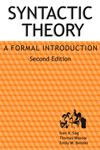

|
|
|
|

Syntactic Theory2nd Edition Click here if you are considering adopting Syntactic Theory for a course. The second edition of Syntactic Theory: A Formal Introduction expands and improves on a truly unique introductory syntax textbook. Like the first edition, it focuses on the development of precisely formulated grammars whose empirical predictions can be directly tested. There is considerable emphasis on prediction and evaluation of grammatical hypotheses, as well as on integrating syntactic hypotheses with matters of semantic analysis. The step-by-step introduction to a consistent grammar covering the core areas of English syntax is complemented by extensive problems sets drawing from a variety of languages. The student covers the core areas of English syntax from the last quarter century, including: complementation, control, 'raising constructions', passives, the auxiliary system, and the analysis of long distance dependency constructions. The theoretical perspective of the book is presented in the context of current models of language processing. The practical value of the constraint-based, lexicalist grammatical architecture proposed has already been demonstrated in computer language processing applications. The thoroughly reworked second edition includes revised and extended problem sets, updated analyses, additional examples, and more detailed exposition throughout. An on-line instructor's manual for Syntactic Theory, 2nd Edition is now available. Visit the on-line Syntactic Theory Instructor's Manual by Emily M. Bender, Ivan A. Sag and Tom Wasow, for chapter-by-chapter lecture notes and downloadable transparencies to go with the lectures. In addition, there are sample solutions to all the problems in the text. Contents
Praise for the first edition of Syntactic Theory
“Syntactic Theory sets a new standard for introductory syntax volumes that all future books should be measured against.”
“Syntactic Theory is, without a doubt, the best available introduction to unification-based syntactic theory.”
“My undergraduate students loved this book.”
“A clear, thorough, and up-to-date introduction to a formal theory of grammar, it meticulously takes the reader through detailed analyses of many important aspects of English syntax, suggests applications to other languages, and evaluates the theoretical model employed from broad historical and intellectual perspectives.”
Ivan A. Sag (1949–2013) was Professor of Linguistics and Thomas Wasow is Professor emeritus of Linguistics and Philosophy at Stanford University, where they also served on the faculty of the Symbolic Systems Program. Emily M. Bender is now Professor of Linguistics at the University of Washington. Translated into Japanese.4/15/2003 ISBN (Paperback): 9781575864006
Books by Ivan A. Sag
Books by Thomas Wasow
|
Distributed by the
University of Chicago Press |
|
pubs @ csli.stanford.edu
|
CSLI Publications
Stanford University Cordura Hall 210 Panama Street Stanford, CA 94305-4101 (650) 723-1839 |